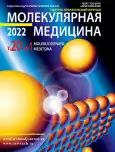Influence of κ- and λ-carrageenans from Chondrus armatus on colon cancer cells proliferation RKO and HCT-116
- Authors: Tiasto V.A.1
-
Affiliations:
- Far Eastern Federal University
- Issue: Vol 20, No 1 (2022)
- Pages: 46-52
- Section: Articles
- URL: https://journals.eco-vector.com/1728-2918/article/view/113551
- DOI: https://doi.org/10.29296/24999490-2022-01-08
- ID: 113551
Cite item
Abstract
Introduction. To this date the search for new substances with antitumor activity is an urgent task of pharmacology and medicine. Carrageenans are sulfated galactans of red algae, they are promising substances for the basis of future drugs, as well as for t he creation of preventive antitumor agents. In this work, we investigated the antitumor effect of carrageenans, different in structure and molecular weight, isolated from the algae Chondrus armatus on the cell lines by colon carcinomas and colorectal carcinoma. Aim of the study: comparative study of the antitumor effect of κ- and λ-carrageenans from the red alga Chondrus armatus and their oligosaccharides on tumor cell lines RKO and HCT-116. Material and methods. Carrageenans κ- and λ- and their oligosaccharide derivatives (κ- and λ-) were derived, characterized by structure (IR spectrometry) and molecular weight (Choromatography), and tested on RKO colon carcinoma and HCT-116 colorectal carcinoma cell lines. The antitumor effect was assessed using the MTT assay-cell proliferation assay and using fluorescent cell dyes of vivo Hoechst staining and propidium iodide to stain living and dead cells. Results and discussion. According to these data, carrageenans and their oligosaccharides exhibit a pronounced inhibitory effect on the proliferation of intestinal carcinoma tumor cells. Carrageenans κ- and λ- had a significant antitumor effect at a maximum concentration of 400 μg / ml during incubation for 24 and 48 hours in the investigated cell lines of intestinal carcinomas RKO and HCT-116. Conclusion. It was shown that oligosaccharides κ- and λ-carrageenans, isolated from the red alga Chondrus armatus, exhibit a pronounced inhibitory effect on the proliferation of human intestinal cancer tumor cells, without increasing the percentage of dead cells. Consequently, these carrageenans exhibit a pronounced antitumor effect blocking cell growth
Full Text
About the authors
Vladlena Alexandrovna Tiasto
Far Eastern Federal University
Author for correspondence.
Email: tiasto_va@dvfu.ru
research assistant scientist in laboratory of Pharmacology and Biotesting, School of biomedicine
References
- Marmol I., Sanchez-de-Diego C., Pradilla Dieste A., Cerrada E., Rodriguez Yoldi M. J. Colorectal carcinoma: a general overview and future perspectives in colorectal cancer.International J. of molecular sciences. 2017; 18 (1): 197-205. https://doi.org/10.3390/ijms18010197
- Sithranga Boopathy N., Kathiresan K. Anticancer drugs from marine flora: an overview. J. of oncology. 2010; 2: 214-20. https://doi.org/10.1155/2010/214186
- Yuan H., Song J., Li X., Li N., Dai J. Immunomodulation and antitumor activity of κ-carrageenan oligosaccharides. Cancer letters. 2006; 243 (2): 228-34. https://doi.org/10.1016/j.canlet.2005.11.032
- Stortz C.A., Cerezo A.S. The 13C NMR spectroscopy of carrageenans: calculation of chemical shifts and computer-aided structural determination. Carbohydrate Polymers. 1992; 18 (4): 237-42. https://doi.org/10.1016/0144-8617(92)90088-8
- Haijin M., Xiaolu J., Huashi G. A к-carrageenan derived oligosaccharide prepared by enzymatic degradation containing anti-tumor activity. Journal of Applied Phycology. 2003; 15 (4): 297-303. https://doi.org/10.1023/a:1025103530534
- Khotimchenko M., Tiasto V, Kalitnik A., Begun M., Khotimchenko R., Leonteva E., Bryukhovetskiy I., Khotimchenko Y Antitumor potential of carrageenans from marine red algae. Carbohydrate Polymers. 2020; 246: 116568. https://doi.org/10.10Wj.carbpol.2020.116568
- Cicinskas E.A, Begun M.A., Tiasto V.A., Belousov A.S., Vikhareva V. V, Mikhailova V.A., Kalitnik A.A. In vitro antitumor and immunotropic activity of carrageenans from red algae Chondrus armatus and their low-molecular weight degradation products. Journal of Biomedical Materials Research. 2019; 108 (2): 254-66. https://doi.org/10.1002/jbm.a.36812
- Lins K.O, Bezerra D.P, Alves A.P, Alencar N.M, Lima M.W, Torres V.M., Farias W.R, Pessoa C., de Moraes M.O., Costa-Lotufo L.V. Antitumor properties of a sulfated polysaccharide from the red seaweed Champia feldmannii (Diaz&Pifferer). J. of Applied Toxicology. 2009; 29 (1): 20-6. https://doi.org/10.1002/jat.1374
- Yermak I. M., Khotimchenko Y. S. Chemical properties, biological activities and applications of carrageenan from red algae. Recent advances in marine biotechnology. 2003; 9: 207-55.
- Robal M., Brenner T., Matsukawa S., Ogawa H., Truus K., Rudolph B., Tuvikene R. Mono-cationic salts of carrageenans: Preparation and physico-chemical properties. Food Hydrocolloids. 2017; 63: 656-67. https://doi.org/10.1016/j.foodhyd.2016.09.032
- Suganya A.M, Sanjivkumar M., Chandran M.N, Palavesam A., Immanuel G. Pharmacological importance of sulphated polysaccharide carrageenan from red seaweed Kappaphycus alvarezii in comparison with commercial carrageenan. Biomedicine & Pharmacotherapy. 2016; 84: 1300-12. https://doi.org/10.10Wj.biopha.2016.10.067
- Ariffin S.H, Yeen W.W, Abidin I.Z, Abdul Wahab R.M, Ariffin Z.Z, Senafi S. Cytotoxicity effect of degraded and undegraded kappa and iota carrageenan in human intestine and liver cell lines. BMC Complementary and Alternative Medicine. 2014; 14: 508. https://doi.org/10.1186/1472-6882-14-508
- Calvo G.H, Cosenza V.A., Saenz D.A, Navarro D.A, Stortz C.A, Cespedes M.A, Mamone L.A, Gasas A.G, Di Venosa G.M. Disaccharides obtained from carra-geenans as potential antitumor agents. Scientific reports. 2019; 9 (1): 6654. https://doi.org/10.1038/s41598-019-43238-y
Supplementary files










